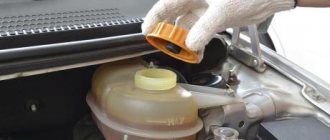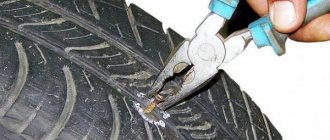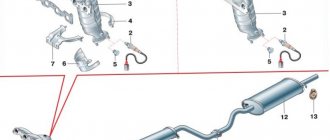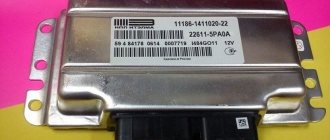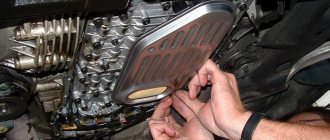A large number of car owners prefer to repair their vehicles themselves, using tool kits and a regular garage. Some people even do this in the yard, although this option is not the most acceptable. But certain repair work requires lifting part or the entire car, otherwise it will not be possible to get to the problem unit. If we talk about car services, then there is specialized equipment in the form of powerful lifts, as well as equipped inspection pits, from where a technician can easily get to the required part, remove it, replace or repair it. Few ordinary motorists own a service station, and therefore you need to look for alternative options for lifting your car so as not to overpay for car service services only because of the lack of means to lift the car. But if you decide to take on such work yourself, follow all safety rules very strictly. Not every method discussed will be right for you. Analyze carefully and take into account your technical and physical capabilities. There's no point in taking unnecessary risks. Sometimes it’s really better to go to a trusted car service center.
Methods for lifting a car for repairs.
How to properly lift a car on a lift?
It is best to place support platforms under box-shaped body elements. We remember that the lift
should not rest against the bottom until the support pads touch the designated places on the body.
To prevent spontaneous movement of the lift
, they must be blocked using clamps.
Interesting materials:
How to view yesterday's sites? How can I watch a video that I watched on VK? How to view Pinned in telegram? How to view CCTV footage? How to install adblock in chrome? How to put an apostrophe on the Ukrainian keyboard? How to put an apostrophe on top? How to put an apostrophe in English? How to put an apostrophe at the top? How to park a car in transit?
Security issue
Quite often, car owners are faced with a problem when they do not have a special overpass, lift or pit in the garage for repair and restoration work. For many, the only option is to use a jack. But this method can hardly be called absolutely safe. Before you get to work and crawl under a raised vehicle in your own garage, there are a few things to consider that are directly related to your safety.
- Before starting any work that requires lifting the car with a jack, be sure to check that it is in good working order. Jacks can gradually wear out and fail. Therefore, before each procedure of using a lifting device, you need to make sure that nothing is broken and that the jack is able to fully perform its tasks.
- Match the weight being lifted to the capabilities of the jack. Each jack is designed to lift a certain weight. And motorists often violate this requirement, which leads to serious and dangerous consequences. Before loading the device with the weight of a vehicle, make sure it can support it. Therefore, it is very important to choose jacks with a reserve load capacity.
- Stands. A simple but effective homemade remedy to increase your own safety. Wooden boards or bars are used as stands. Usually 2-4 pieces are enough. First, the car is lifted with a jack, and then stands are installed under the car. This makes the car much more stable.
- Wheel chocks. These are special designs that prevent the car from rolling away. You should not rely completely on the handbrake. Even with a perfectly flat surface during repair work, you can jerk the car and it will roll. Literally a few centimeters of displacement is enough for the car to be torn off the jack. Think in advance about how to lock the wheels.
- Using several jacks at the same time. If the machine is heavy, or you need to lift not just part of the machine, but the entire machine, you should use several lifting devices at once. At the same time, safety stands are used.
- Telephone availability for communication. Always keep it handy. Situations can happen different. And if you suddenly get pinned under a car, which we hope never happens, you can call and call for help.
Safety comes first. Before carrying out any repair work in your garage that requires lifting the car, create all conditions for safe work. This is not so difficult to do, but it is extremely important for the safety of your health and life.
Main malfunctions and their causes
Among all the reasons why a hydraulic rolling jack, bottle jack or diamond jack does not work, there are 3 main options: system clogging, valve failure or rod damage. It is on these 3 pillars that the most common breakdowns associated with a decrease in efficiency or complete failure of the system are based. For greater clarity, let's look at each case in more detail.
System clogged
may be caused by air, dust or dirt entering the liquid. As a result of the first option, the jack stop may not rise, spring strongly, or even fall completely under load. Accumulated lumps of dirt can limit the movement of the valves, which will no longer tightly close the channels, allowing fluid to pass in both directions. In this case, the stop will not be fixed in one position, gradually lowering to the zero point
When figuring out the circumstances why the hydraulic jack does not hold, first of all you should pay attention to the cleanliness of the system
Valve failure
, in addition to mud clogging, can be caused by mechanical damage. The ball at the end of the spring, resting in a cone-shaped groove, can become detached or get caught on other structural elements. In this case, the rod will not rise at all, since the circulation of liquid in the system is disrupted and pumping is not performed. This breakdown is more complex and requires disassembling the device. It is not recommended to consider it before checking the system for blockages.
Rod damage
may occur due to non-compliance with maintenance or storage conditions, as well as from working with large loads and violating operating rules. In the first case, the piston may become corroded, which will reduce the tightness of its seal to the cylinder, resulting in liquid leakage. If you lift loads that are heavier than the permissible limit, the stop may bend. The chances of such a breakdown increase with the maximum extension of the screw and uneven installation of the jack on the ground. Rod deformation is considered the most serious failure, which cannot always be repaired even in special centers.
Having covered the main causes of malfunctions, let’s move on to specifics. We will analyze the main problems and offer solutions.
Doesn't hold under load
The descent of the rod when resting on the load and even without strong pressure can be caused by two reasons: lack of oil or faulty valves. To find out for sure why a hydraulic rolling jack lowers, it is better to go from simple to complex. We will analyze each option separately, according to the degree of complexity of the repair procedure.
- The lack of oil is associated with banal leakage in the absence of sealing. It may be a consequence of long-term storage of the tool with the shut-off valve unscrewed or wear of the gaskets. The problem is solved by adding fluid and pumping the jack. It is better to use special hydraulic oil, but simple industrial oil will do just fine. If after filling the liquid leaks out, even with the valve tightly closed, it is worth purchasing a repair kit and replacing all the gaskets.
- Valve failure can be caused by system clogging or mechanical damage. If the rolling hydraulic jack does not hold, it is not necessary to disassemble it immediately. It would be more rational to first rinse the internal channels, which may be clogged with dirt. To do this, drain all the oil from the system and fill it with flushing liquid (you can use kerosene or gasoline). We pump several times, drain and repeat the procedure a couple more times using clean liquid.
Home maintenance
box for the kitchen (on the left against the wall)
The house is constantly “breathing”.
When the heating works, when it doesn’t, everything moves. To hang the kitchen, it was necessary to build a metal frame, cover it with plasterboard, and only attach the kitchen to it. No other way. The sliding wardrobes so beloved by our citizens are absolutely impossible to install - there is nothing to “attach” to, and the wall and ceiling live their own lives. The staircase, which was “tied” to the wall, eventually became warped and the railing was torn out.
instead of a wardrobe...
Any decorative boxes covering communications turn into a work of art - they must somehow be combined with a log wall
, and this process turns into jewelry fitting with a construction cutter in hand.
The joints sealed with sealant were sealed twice in 4 years. Still, cracks appear
. The wooden floor on the 2nd floor is also drying out, there are also cracks, and this is inevitable.
crack between logs
Mice enter the house in the fall
, in the gap between the lower log and the foundation. It is not yet possible to block this road for them, since the interface line is very uneven. And if on the main “animal trails” this phenomenon can be reduced to “nothing” with the help of poison and mousetraps, then when mice frolic between the logs without “visiting”, nothing can be done with them. Just curse it.
make their nests between logs every year.
. The issue is resolved with the help of Dichlorvos. But it still has to be decided.
In autumn and early winter, the second floor is a kingdom of flies. First, the flies get stuck in the cracks
for the winter. Then the house becomes warm - and they climb inside. We have not yet come up with any other means against this brethren except a vacuum cleaner.
We are also the best friends of Tikkurila paint sellers. There needs touching up
, here you need to tint: steps, joints, terrace. They didn’t keep accurate records of production, but a lot of buckets of paint were purchased over 4 years.
In the spring, when the pine tree (and then the birch tree) blooms, the whole house is covered with
yellow
pollen
. Moreover, in a thick layer. On a flat vertical wall, so much of it simply would not accumulate. This issue is resolved by washing the walls with a jet from a Karcher. But again it needs to be resolved.
Bath
Inside the house, dust accumulates on the bend of the logs
. There are no universal means here - dust can only be removed manually, the old fashioned way.
Sometimes spontaneous, inexplicable bursts of life happen inside the house - some bugs, midges, insects appear, but I haven’t installed any system here yet.
In the bathhouse, near the guest bed, some kind of perky creature lives in a log, crunching the log all night. It is not possible to find and kill her.
And finally, about the famous “winter” forest. My house was cut down from February. The bathhouse is from August. I still haven't noticed a difference.
Price issue
Considering all of the above, such housing cannot be called cheap. House with a total area of 240 sq. m. (with a small attic floor) cost me $40,000 only at the first stage: foundation, box and roof. Then the project grew, we also built an outbuilding, a bathhouse from the same “round timber,” and landscaped the area and the street next to the house. All this (including materials, finishing, windows, doors and geothermal boiler) cost us a total of $180,000.
shrinkage to the roof
Conclusion:
What we got for this torment was a very beautiful house. And some kind of indescribable pleasure from the feeling of a thick, uneven log, its rough appearance, rich texture... Friends who began to build across the site from mine listened to approximately the same text, my complaints and advice to build from blocks. And in the end... the log house was also cut down. Here, of course, everyone decides for themselves. But I gave you fair warning.
Interviewed by: Dmitry Malakhov
Place for a car at the dacha made of monolithic concrete
The construction of such a site begins traditionally. That is, we remove the soil to a depth of 300 mm.
Next, you need to lay down non-woven material and cover it with a 100 mm layer of sand.
After this, we level the sand, pour it with water and tamp it.
Next you need to install curbs. The height of the curb should be such that it ends up on the same level as the finished site.
Now we lay medium-fraction crushed stone 100 mm thick, level it and tamp it.
If installing curbs is not part of your plans, then it will be enough to make formwork from boards of the required height.
The next step is to lay the reinforcing grid and you can pour concrete in a layer of about 100 mm.
It’s good if you have the opportunity to bring ready-made cement mortar. Then all you have to do is first level it on the site and, using the rule, finally bring the surface of the site to an acceptable condition.
For example, before this.
Lifting mechanism.
Manual chain hoist. A manual chain hoist is used as a lifting mechanism. Now you can buy an electric chain hoist. It is much more convenient and safer to work with it. The lifting capacity of the hoist (winch) must be at least 750 kg. |
Transportation device.
Transportation device. The device for transporting the lifted load consists of a wheel - a pulley and an L - shaped structure from which the hoist is suspended. The wheel-pulley rides along a metal guide beam. The wheel must be on a bearing. My first design (without a bearing) moved along the guide under load with great difficulty. In the photo there is an old water pump from a truck (a durable pulley on a powerful bearing), to the body of which an L-shaped suspension is welded. |
Pulley on guide. You can come up with any design, but the main thing is that the wheel has sides that do not allow it to jump off the guide. |
Features of sites with different surfaces
Coarse sand or fine granite chips (1-4 mm) are poured under paving slabs, bricks, flagstones, rubber tiles. Please note that for car parking, tiles need to be at least 50 mm thick (for paths, you can take from 30 mm). One more point: the smaller the size of the tiles used to pave the parking lot at the dacha, the less noticeable will be the inevitable “game” of the levels of the bricks.
Different coatings for summer cottage parking lots have their own installation characteristics.
Natural stone and concrete slabs
If you decide to make a parking lot from natural stone cut into slabs, it should also be 4-5 cm thick. You should not lay too large pieces: there is a high probability that they will break. They should not be placed closely, but leaving gaps of a couple of millimeters. The gaps are filled with sand, to which you can add abrasion-resistant lawn grass seeds. If you make the same paths, it will turn out beautifully, organically, and there will be no dirt.
With natural stone everything looks very decent
If the grass doesn’t appeal to you (it’s more difficult to clean, you have to cut it somehow), fill the gaps between the slabs with a mixture of sand and cement (1 part cement, 3 parts sand). Sweep it off the stones so that there is nothing on them and water the area (not with a stream, but with small drops, and so that it does not flow). The mixture will turn into concrete. It will take a certain amount of time to gain strength: 7 days at a temperature of +20°C to achieve 50% strength and another two weeks for complete “ripening”. Until the strength reaches 50%, it is advisable that there are no rainfalls during this period, and if they start, cover the area with polyethylene. Water itself is not scary, but streams that can wash away fragile concrete are scary.
This option has only one drawback: the high price of the stone. To reduce costs, you can use ready-made paving slabs in large format: 50*50 cm or so. They are also laid on a gravel-sand bed. Everything is the same, only the slabs are of artificial origin and have a clear geometry.
Concrete
For a concrete site, you will need to install formwork around the perimeter. Then you will need to make a reinforcing frame in the form of a cage from a metal rod. A rod with a diameter of 10-15 mm is taken, a lattice is folded from it in increments of 10-15 cm, and tied at the joints with a special wire (knitting). The resulting mesh is placed on stops so that it is raised above the compacted crushed stone by 3-5 cm, and the layer of concrete on top should also be at least 10 cm (preferably 15).
If a concrete parking lot at a dacha is made for two or more cars, expansion joints will be required. To do this, wooden planks 0.7-1 cm thick are laid edgewise on a grid of reinforcement. The width of the planks is equal to the height of the concrete layer (they can be used as guides when leveling the concrete mixture). They are laid in increments of 2 meters.
Concrete parking for a car at the dacha in the process of being manufactured
In the case of concrete, you will have to wait quite a long time for your parking lot to start using. The concrete must stand for at least 28 days. And this is if the temperature does not drop below +20°C. At the same time, you need to ensure that the surface does not dry out. To do this, you need to water the area, and to prevent the water from drying out quickly, throw matting, old bags, etc. on top, throw a piece of polyethylene on top. This coating helps maintain humidity, equalizes temperature (local overheating is harmful) and protects the surface from drops that are inevitable when watering.
If you can’t wait that long, add an “accelerator” to the concrete. An additive that accelerates the hardening of concrete. The period may be reduced to 7-10 days. But carefully read the features of caring for such concrete.
Green lawn parking
When constructing a green parking lot, special grates are placed on a layer of gravel, the gaps of which are filled with fertile soil and sown with grass seeds. To park a passenger car, and sometimes even a jeep, a grate with a height of 10 cm is sufficient. If heavy vehicles (trucks with materials) are to be placed on the site for unloading, a grate is needed with a height of at least 15 cm.
The difference in the cost of gratings for green parking is significant. But the difference in price is usually justified: some eco-parking lots do not sag and look normal, while others crumple, turning the surface into a mess of soil and grass. Therefore, when choosing gratings, do not go for cheapness.
Lawn parking for cars at the dacha
Taking care of a grass parking lot is not very convenient: the rake gets stuck in the grate, and not every lawn mower can operate safely. Therefore, many owners of such sites are disappointed. But recently, another trend has appeared - instead of soil and grass, medium crushed stone is poured into the grates, and the top is covered with small crushed stone or pebbles. How is this option better than a regular bulk site? The platform is not pressed under the wheels of even a heavily loaded vehicle. This option is ideal for clay soils.
Our verdict
As you can see, all methods work. Which of them to use depends on the circumstances and possibilities: is there a hill nearby on which you can arrange a diagonal hanging, is there a shovel in the car or something for building the same overpass, for use as a support. Here we will give some advice: in our forests and fields there is enough all kinds of garbage that can be used for these purposes. For example, the same bricks and blocks for support were found quite by accident already at the shooting site. The boards, of course, are prepared, but having them in the winter season is a good habit.
Tire fittings in the Automotive Business ad database
Replacing the jack
When using scrap materials as a lift, install structures in the space near the wheels, where jacks are welded on or appropriate recesses are made for installing a jack.
Wooden coasters
You can lift the car to change a wheel or inspect the bottom using small blocks.
Wooden supports can be installed on one side of the body, or the car can be completely raised on them.
Stones and dug hole
This method is useful on roads with sandy sides. The vehicle should be pulled to the side of the road and parked so that the wheel that needs replacing is on an embankment.
Using a shovel, you will need to dig a hole around the wheel. As you go deeper, you need to substitute stones to prevent the machine from tipping over. Once the wheel is suspended, it can be deflated and removed.
Border
On city roads, you can lift the car onto the curb. To do this, place a board on a raised platform and roll the car over it with the side where the tire is punctured.
As soon as the car rises to the desired height and the board takes a position parallel to the ground, we place supports made of stones or wood in the places for the jack.
See also:
An easy way to quickly inflate your car tires
Layers: general sequence
After you have selected a parking space for your car at the dacha, mark out the selected dimensions of the site (taking into account the drainage system). Next we work in this order:
- We remove a layer of soil 30-35 cm deep.
- We remove all the stones, roots, and level it (it’s not necessary to go into the horizon, but there shouldn’t be any holes or humps).
- We take a tamper and compact the soil.
Example of layers for a parking lot made of paving slabs - We spread geotextiles. Its dimensions should be 0.7-1 meters larger than the dimensions of the site, the edges should wrap around the edges of the pit for parking a car. When installing drainage, a drainage pipe is wrapped in “excess” geotextile. And so, the edges can be hidden under the grass, pressed with a border, or sprinkled with a layer of gravel.
- Pour a layer of sand, level it, tamp it down. When compacted, the layer is 10-15 cm. To make compacting easier, the sand is wetted with water.
- Add a layer of crushed stone. It is advisable to use two fractions: large and medium. A layer of coarse gravel (20-40 mm) is laid on the sand, leveled, and compacted. Its thickness is 10 cm when finished.
- A layer of medium gravel (5-20 mm). Leveled, compacted. Its thickness is also approximately 10-15 cm.
For now, an exotic option for our summer cottages is rubber coating.
In general terms, these are all the rules and features of arranging a parking lot in a country house. More precise layer sizes depend on the structure of the soil and the planned load. For example, for loose (sands and sandy loams) and unstable (peat bogs) soils, to give greater stability, a road mesh can be laid at the bottom of the pit. It will eliminate pushing.
Second example: a layer of geotextile can be laid between sand and gravel. The bottom layer (at the bottom of the pit) is necessary to stabilize the base and also to prevent plants from sprouting. Intermediate layers provide more reliable plant protection and also prevent layers from mixing. In this case, even a heavy vehicle will not leave a rut.
Parking at the dacha: pros and cons of different options
A separate and very important advantage that parking in a dacha made of crushed stone provides is natural drainage. You do not need to build drainage. Water seeps between the stones and goes into the ground, taking with it pollution. But this type of site is not suitable for areas with high groundwater levels. Standing in a puddle on rubble is not the best solution to the problem, although the problem can be solved by creating a drainage system for the entire area.
Green parking has become increasingly popular in recent years. This is not an ordinary lawn, but a special one. A plastic grid is hidden under the grass, which redistributes the load on the ground and prevents the wheels from falling through. Caring for such a parking lot is similar to caring for a lawn - mowing, watering. Weeding is not required, since the preparatory work involves removing the soil, that is, most of the roots go away. The varieties of herbs used are special, and this is the problem: they are expensive. The second disadvantage is the possibility of freezing (the seeds are expensive, and the greens do not grow too quickly). But it's beautiful. And it can be used not only as a parking lot, but also as a recreation area.
Parking grates are not plastic, but concrete with holes for grass
A platform for a car in a country house made of paving slabs is the best option for a hard surface for heaving soils. And the water does not stay for too long - it goes into the cracks between the tiles, and the integrity of the coating does not suffer during heaving. Two more options: concrete and asphalt country parking are reliable and durable, but only if all preliminary work is carried out correctly. Their disadvantage is that they are expensive, and the appearance of cracks is very noticeable.
Undermining
Technology: if you have a shovel or the soil allows you to dig with improvised means (for example, there is sand under the wheels, there is a small piece of plywood or a piece of board), you can dig under the wheel and unload it in this way. Of course, before this you need to provide support.
After replacing the wheel, the hole should be filled, but it is unlikely to provide good support, so the question arises of how to remove the car from the support. There are several options:
- dig up the support itself;
- provide for the possibility of easy dismantling of the support (for example, it is a column of several bricks - it is enough to knock out one or two intermediate bricks);
- make a small rise/overpass in front of the replaced wheel (following the principle of the previous method);
- slightly lift the body (enough for the suspension travel) to remove the support, but in this case you will need an assistant.
Advantages:
- an assistant is not required.
Flaws:
- it will take time to dig/bury a hole and remove the car from its support;
- It will be difficult to dig a hole without a shovel;
- you still need some kind of tool, as well as support;
- This method is only suitable for replacing a wheel - the previous ones allow you to lift the body itself, which can also be used for other repair work.
Suspension “bad roads”: we use the package ourselves
Many motorists have always been interested in the concept of the “bad roads” package, which is offered in showrooms for many brands and models of cars. In fact, it's just a set of suspension parts with slightly different characteristics. In particular, the package includes a different type of strut and spring, sometimes including spring stands certified at the factory. There are several important features of using such a package independently:
- it is necessary to change the struts, since many people prefer to install only higher springs, but without replacing the struts the car will not be safe and of high quality in operation;
- It’s better to choose original springs if your car has the concept of a “bad roads” package, but there are also a lot of analogue solutions, it’s worth paying attention to the quality;
- the kit may also include steering parts, supports, bearings with enhanced wear resistance, but all this is an optional addition to the package;
- the installation of new struts and springs must be professional, otherwise the achieved result will be immediately deteriorated by the poor quality of installation of the main parts of your suspension;
- It is strictly prohibited to use Chinese cheap spare parts or struts and springs that are not certified for cars, unless you have experience in designing cars.
The modifications are quite simple, you need to buy struts and springs, replace them and enjoy the additional 2-2.5 cm of ground clearance. You can easily combine the first and second steps and get about 4 cm of increase below the bottom point. At the same time, the costs will be quite tolerable, since the struts will change sooner or later, as well as tires and wheels. Next time your struts need replacing, look into the bad roads package.
What kind of crushed stone is needed
The answer to this question has already been briefly mentioned here - any answer except limestone. By filling the area with river gravel, you will get a soft, reliable surface on which you can walk barefoot.
Crushed granite has sharp corners; walking on such a surface without shoes is not comfortable, and it is more expensive than other types.
Limestone will not withstand constant moisture, it will gradually decompose, the site will end up with a deep rut with constant water, there is no point in using it, savings are inappropriate here.
Ways to lift in the garage
If repair work is planned to be carried out in a garage, then you need to think about how best to lift the car when a powerful lift is not available. There are several methods for lifting a vehicle in a garage. And sometimes there is no need to lift anything at all, since many of these rooms have holes. They are the ones who help car owners carry out repairs and maintenance work on their own, without turning to car service specialists for help, thereby significantly saving their budget. But the problem becomes relevant again when you don’t know how to lift a car in a garage without an inspection hole. It is not available everywhere, so we have to look for alternative solutions. If there is no hole, you can use:
- jack;
- stands;
- with improvised means.
Each method should be described separately so that you can take into account important nuances and follow certain rules.
Using a jack
Almost every motorist has a jack. This device should come as a basic package when purchasing a car. If the car was taken from the secondary market, and there was no jack there, one of the primary tasks of the new car owner is to buy a good lifting device. The danger of a jack lies mainly in violating the rules for its use. Some drivers simply overload the device, not calculating the load on the mechanism from too much weight of the car. Others buy low-quality models that cannot withstand even several cycles of operation under load. But there is another problem: when the jack is good, its quality does not raise any questions, it still breaks on the car. This is due to improper installation of the device. There are 2 key rules to follow here.
- The supporting place on which the jack is installed must be firm and level. If the surface is curved or loose, the stability of the lifting mechanism will be disrupted and the machine may collapse at any time. When garages use concrete or wood floors, there are no problems. But if there is ground under the wheels, be sure to first place a lining made of durable material under the jack itself. A sheet of metal or wooden boards will do.
- The jack should rest against the vehicle side members. In the thresholds of cars, designers provide for the presence of special grooves into which the jack is inserted. But here the metal is often quite soft, which is why it begins to dent after frequent use. The spars are much more stable and therefore able to withstand multiple load cycles.
Site type
Parking for your car can be open or covered. Open parking is the most budget option. A canopy will cost significantly more - pipes, a canopy, and additional work will be required. But we must remember that a canopy is not a closed garage and will not significantly protect the car from heat and ultraviolet rays. The height of the canopy should not be high, otherwise all the meaning of its installation is lost. During snowfall, a high canopy will not save the roof of the car from a thick layer of snow. The optimal height is 2.5 meters.
A garage is a reliable shelter, parking, and a place to store all household tools. But in terms of money, it is the most expensive structure; if you do not have construction skills, you will have to hire builders. The garage is being built on the site itself; there must be free space for this. Otherwise - near the yard, nearby, open, inexpensive and fast. If your health allows it, you can do everything yourself.
Causes of major malfunctions
Even taking into account the fact that hydraulic jacks are considered the most durable, they are not immune to breakdowns. This applies to both bottle and roll-type devices.
The reasons that the jack does not work may be wear of old parts, as well as improper operation. As practice shows, most often failure of oil equipment occurs due to lifting loads whose weight exceeds the maximum permissible. Malfunctions of automotive and other types of hydraulic jacks are associated with various problems. When analyzing them, the following important points must be taken into account:
Often we have to deal with the failure of the hydraulic cylinder, which is the main element of the entire structure, as well as damage to the plunger mirror. As a result, the working part of the device does not maintain the required pressure, and oil, in turn, enters the space above the piston. Typically, the mirror is damaged due to improper use of the equipment. We are talking about transporting a bottle-type device in a horizontal position, if this is not provided by the manufacturer. Due to serious damage to the mirrors, leaks of working fluid and penetration of air occur, leading to active corrosion. It causes accelerated wear of sealing elements made of rubber that is susceptible to mechanical stress. Damage to the cuffs leads to foreign particles entering the oil, clogging the valves and channels. If a jack falls from a great height, significant damage to its elements (both internal and surface) is possible. Frequent excessive loads can lead to failure of the mechanism and its serious damage. One of the most common problems is a bent rod, due to which the working chamber begins to leak oil.
It is important to remember that each specific model is designed for a certain load, exceeding which inevitably leads to breakdown of the lifting equipment. All relevant parameters are specified in the operating instructions for the jacks. Among other things, you can find yourself in a situation where the hydraulic mechanism leaks if it is not used for its intended purpose.
In this case, we are again talking about ignoring the manufacturer’s recommendations regarding the operation of devices.
Naturally, this is an incomplete list of reasons why a jack may require repair.
Diagonal hanging
Technology: we find a small steep hill or other suitable elevation - and drive up it with one wheel, causing a diagonal hanging. For example, if we drive with the front left wheel, the left rear will come off the ground, and the right front will be seriously unloaded (after all, the front axle is more loaded).
If necessary, you can lift the front wheel off the ground, increasing the lift, adjusting the trajectory of the ride, or even turning the car around and driving up the hill in reverse. If there is no suitable slide, you can try to construct a homemade overpass.
Advantages:
- the simplest and fastest way to lift the wheel off the ground;
- no additional devices or tools are needed at all;
- no assistant needed.
Flaws:
- it is not always possible to find a suitable hill or replace it with a homemade overpass;
- On some models (with poor geometric cross-country ability, long-travel suspension), it is not easy to arrange diagonal hanging, especially in conditions that are poorly suited for this.
Why did the jack break?
In fact, damaging it is a piece of cake. Most often, a breakdown occurs when the jack is placed on a soft surface, tilts during operation and folds unsuccessfully under the weight of the machine (the threshold can also damage). So we recommend installing a base (at least a board) under it on soft surfaces.
By the way, sometimes buyers of old cars are not even aware of the condition and completeness of the standard tool for changing wheels. When inspecting the car, we saw a “spare wheel” - and okay. Therefore, our advice: take 10-15 minutes to check the operation of the same jack and the condition of the spare tire, at least the pressure in it. There have been cases when drivers had everything they needed to change a wheel, but could not do anything due to soured fasteners!
